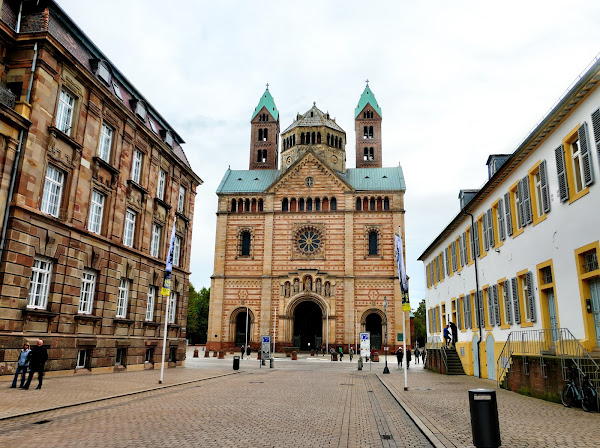Final Days: Cologne, Kinderdijk, and Amsterdam
But why is there such a magnificent structure in Cologne in the first place? The answer lies in the photo at the top of this blog. The reliquary. Indeed, the answer literally does lie there. In 314, Emperor Constantine gave the "relics of the Magi" to Eustorgius I, the Bishop of Milan, who brought the relics to Milan. In 1164 the Holy Roman emperor Frederick Barbarossa took the relics from Milan and gave them to Rainald of Dassel, the Archbishop of Cologne. In 1180 work was begun on the reliquary and was completed around 1225. The business of relics seems strange to moderns--both believers and unbelievers--but there were extremely important during Medieval times. They were especially significant draws for pilgrims or tourists as we could them today. This magnificent cathedral was built to provide a home for the relics and a locations for the thousands who would come to be near them. Of course, today it is the church that draws visitors.
 |
| The Richter window. Note the light reflections cast on the wall to the right |
 |
| A worker showing how hollow chocolate figures are made |
After our walking tour, we returned to the ship for lunch and then set out to find the other big attraction in Cologne: The Chocolate Museum. We didn't have far to go because it was less than a quarter mile from the dock. "The Imhoff-Schokoladenmuseum was opened by Hans Imhoff on 31 October 1993. It is situated in the Cologne quarter of Altstadt-Süd on the Rheinauhafen peninsula. The exhibits show the entire history of chocolate, from its beginnings with the Olmecs, Maya and Aztecs to contemporary products and production methods." It is so extensive that we decided not to see all of it. Of course, we did go through a production area that showed the chocolate making process from bean to finished product. We able to get small samples from the production line.
Kinderdijk
 |
| Kinderdijk |
The next day as we headed toward Amsterdam and the end of our cruise, we spent an afternoon at Kinderdijk. Kinderdijk is a village in the the Netherlands' South Holland province, known for its iconic 18th-century windmills. Its water-management network features 19 mills and 3 pumping stations, plus dikes and reservoirs that control flooding in the polder (low-lying land). Waterways, footpaths and bike trails crisscross the area, leading to the main visitors center and museums in preserved working windmills. (Google)
Over half of the Netherlands is below sea level or with in three feet. Floods threaten from the ocean and fresh water rivers and streams. To protect low lying lands from flows, the Dutch use a variety of dams, levees, and pumps to manage water. The windmills were constructed in the 18th century to progressively move water to higher levels so it could be directed over the levees. This management process was originally called a "war on water" by the government which gives an indication of how serious the problem was. Management is the newer and more apt term. Effectively, all water in the Netherlands is managed since in its natural state it would be destructive.
The major management project was the creation of a 30 km dam that closed off the Zuiderzee, a huge shall bay of the North Sea. This created a freshwater lake. It was completed in 1928 and since then the Dutch have created arable land through the use of polders or a piece of low-lying land reclaimed from the sea or a river and protected by dikes. More recently the Dutch have proposed damming the entire North Sea from Scotland to Norway and France to England. Seems a bit extreme but they have a lot of experience with managing wat.
Amsterdam
Amsterdam is a city of water and bicycles. There are canals throughout the city. Since the 1960's, people have been living in boats--of all types--harbored along the canals. The vast majority of these never move. Some don't even look like boats but in a growing city with limited space, the canals provided a solution. As for the bicycles, they are everywhere. Visitors are warned to be aware of the cyclists because they don't give way to pedestrians
Amsterdam is a very walkable city and we did our share. On our first day we logged eleven miles and nine the next. I also learned after we got home that I was probably exposed to COVID on our first day. I received an alert from the contact tracing app on my phone three days after we got home.
On our second day we spent the morning at the Rijksmueum, the national museum of the Netherlands. We did the heart of the collection tour lasting about two hours and then had lunch in the museum restaurant. It was a sunny Saturday in Amsterdam and thee museum and indeed the whole town was jammed with people out and about. In the Vondelpark, the iconic Amstedam public park, a large crowd was gathered to show support for protestors in Iran.
 |
| The Begijnhof |
We also spent some time visiting a beguinage. "The Begijnhof is one of the oldest hofjes in Amsterdam, Netherlands. A group of historic buildings, mostly private dwellings, center on it. As the name suggests, it was originally a Béguinage. Today it is also the site of two churches, the Catholic Houten Huys and the English Reformed Church." (Wikipedia)
Hope you have enjoyed these as much as I enjoy sharing them. So long till our next trip.







_Enhancer_small.jpg)
Comments
Post a Comment